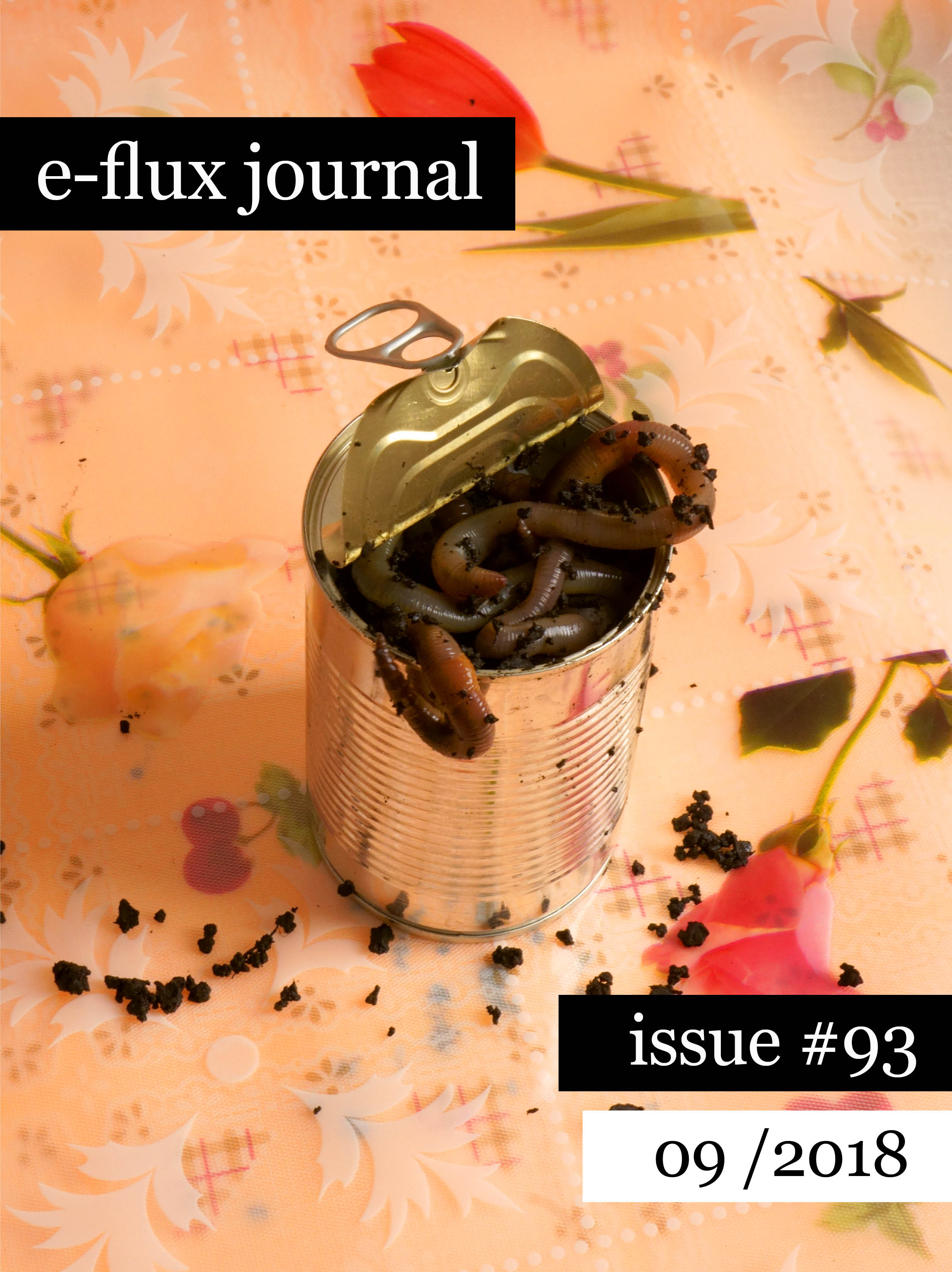e-flux journal issue 93: “on feminisms,” part 2
with Nisi Shawl, Denise Ferreira da Silva, Filipa Ramos, Natalya Serkova, Marwa Arsanios, Nataša Petrešin-Bachelez, Doreen Mende, McKenzie Wark, and Maria Lind
A strange adaptation of an old joke starts like this: a group of feminists walks into a glass ceiling, and a can of worms pours out …
So what happens if the glass ceiling breaks? Who picks up the pieces; who do the pieces fall on? Why haven’t we been setting our sights above it this whole time?
Previously in e-flux journal, we asked:
In ten seconds, how many synonyms can you think of for the word “power”? And then, just when you thought that you finally got the hang of how the power structures around you function, they seem to be coming undone …
What is feminism, precisely? What are feminisms today?(1)
To examine these questions and myriad others, the previous and present issues of e-flux journal have been dedicated to feminism(s). It has been a particular pleasure to embark on an exploration and an unfolding of the many complex realities and iterations that feminisms can accommodate. Not one feminism, but many.
This season, feminisms continues. In this issue, nine authors locate various theories, practices, principles, limits, lineages, and outgrowths of feminisms, in geographies as immediate as the human lap—a space explored in this issue by Filipa Ramos—and as distant as the diplomatically double penetrated Soyuz-Apollo docking system in outer space, whose trajectory Natalya Serkova writes here. Histories of feminist movements are traced back—for example, to the Marxist feminist Alexandra Kollontai, whose work Maria Lind navigates—and projected forward, as in the enclosed science fiction story by Nisi Shawl, which depicts an alternate timeline in which members of a revolutionary social movement motivated by feminist principles send encoded messages to one another by drone. Via Denise Ferreira da Silva, a black feminist poethics takes shape. Marwa Arsanios relays ecofeminist practices taught in refugee camps, passed down from one generation to the next. McKenzie Wark speaks around and through the many, and many-gendered, voices of Kathy Acker. Doreen Mende tracks the archival metabolism of the undutiful daughter. Nataša Petrešin-Bachelez proposes intersectional antidotes to art institutions drenched in shades of white.
Before we delve deeper into the social structures that perpetuate gender inequalities, it is worth taking a step back to think about how gender parameters have been established: Who gets to define what womanhood is? Who gets to write the script of how gender should be performed and to delimit the borders between one gender and another? And more importantly, who gets to blur said borders, and point out how leaky and gray-zoned these concepts tend to be, regardless of any insistence to the contrary? How can we make sure that the tasks of describing, living, and representing gender subjectivities are evenly distributed?
When the distribution of gender subjectivities is not even, we quickly run into problems. Those who manage to excel against the odds become exceptional. Being exceptional sounds much better than it actually is. When you are an exception, nothing that you do has any bearing on the rest of the group that you belong to—because you are in a league of your own, right? Tempting as it may be to be singled out for one’s accomplishments, the price one pays for it is high. If you are an exception, then you are not the norm. You are abnormal. And being denied normalcy is actually a rather uncomfortable way to navigate life, when one actually wants to do normal things, in addition to having a successful career. Thinking about how the label of exceptionalism is applied also makes one think that defining someone’s path as an exception is a quick and easy way to make sure their accomplishments are not easily replicable, and that they don’t get absorbed into the culture.
Now, let’s go back to the question of power, and let’s explore the possibility of defining power by its absence/negation. Withholding your power (such as it is) as a woman could prove to be a valuable exercise in accessing the power structures around you—be it as a clinical exercise in understanding how you connect to them and how they affect or intoxicate you; or to show others what happens in your absence, to make visible your invisibility as a connective tissue of sorts, to demonstrate your value by its absence; or to teach yourself how you too feed the current power structures.
Last year women went on strike in around thirty countries. Some of the guidelines for participation were loose, signaling that this was not your conventional workers’ strike. On Womensmarch.com, instructions were as follows:
1) Women take the day off, from paid and unpaid labor
2) Avoid shopping for one day (with exceptions for small, women-, and minority-owned businesses)
3) Wear RED in solidarity with A Day Without a Woman
In this continuing post-Fordist moment, where is all our paid and unpaid labor located: at work, at home, or everywhere? On the pervasiveness of affective labor, Silvia Federici warns: “The generalization of affective labor, i.e., its dispersal over every form of work, takes us back to a pre-feminist situation, where not only the specificity but the very existence of women's reproductive work and the struggle women are making on this terrain become invisible again.”(2)
How to strike as feminists? Do you sabotage your commute, refuse to feed your child, boycott the family vacation with the kids? Do you write a considerate out-of-office reply and attach a friendly GIF? Do you perform an exorcism, found a coven? Where do I go to work at being a woman and where do I exit the factory, the Lumière Brothers–style outpour at the end of the day? Kathi Weeks asks, “How might feminism contest the marginalization and underestimation of unwaged forms of reproductive labor, without trading on the work ethic’s mythologies of work?”(3)
Should resistance be armed or should it be peaceful? Imagine waking up tomorrow and all the guns in the US are in the hands of women. How would that day end? How many women would be killed at the hands of other women?
Barring this extreme, does striking as a woman entail refusing to smile, or to provide sex or acts of caretaking, maternal or otherwise? Is it a disruption to the pulse of emotional labor, as many second-wave feminists argued? Or, in the complete opposite direction, does striking as a woman involve the embrace, against the grain, of a smirk, a jab, a scream, a frown, an act of radical self-care, of sex, of surrogacy? Does striking consist precisely in caring for others? Perhaps resistance is to be found in the act of making kin where there is none to be found; in embracing excess, and refusing to let others police just how much is too much; in refusing to naturalize both nature and nurture, and deciding to fuck them up, ecosexual-style. While you’re at it, can you kindly let us know where you fall on the spectrum between florasexual and faunasexual?
As you’re probably aware, this was not the first women’s strike. In Aristophanes’s Lysistrata, Athenian women withhold sex from their husbands to protest against the Peloponnesian War that men are waging. In 1895, Susan B. Anthony said, “The women of Kansas should sit by and fold their hands. If they would stop their helping the men for six months, we would have equal suffrage granted us.” In 1970 there was a women’s strike in the US called “Women’s Strike for Equality.” In 1975 there was also a women’s strike in Iceland, but they decided to refer to it as “Women’s Day Off” rather than a “strike.” The wisdom of this decision is attested to by the fact that 90 percent of Icelandic women stopped performing their usual labor for the day. Icelandic men are known to have nicknamed it “The Long Friday.”
Many other forms of refusal have been practiced by women in history everywhere. Consider, for example, the Igbo practice of “sitting on”: gathering to publicly shame, through singing and dance, a man who has committed an injustice but who enjoys impunity under the rule of written law. In the early 1900s, women in British Nigeria also used this practice to protest against figureheads of colonial rule. It is significant that feminists started identifying reproductive labor as such—as labor—around the same time that deindustrialization, off-shoring, and pink-collaring were changing labor conditions. Perhaps the decision in Iceland to refer to the women’s strike by the more appeasing label “Women’s Day Off,” like last year’s “A Day Without a Woman,” speaks to the changing nature of work itself. In Iceland: a gendered version of not-working, of a holiday, because leisure—not nonwork—is the opposite of work. Last year: an apocalyptic extraction, so that a world without women renders itself visible. So you see, many of us, and others before us, bargained decades ago for a party, and all we got was ladies night. Free love! But it got watered down to free beer and a ton of unstructured family ties. Turns out you are relieved from the baby in your lap, only to have a laptop sit there instead. You took the pill but almost overdosed on estrogen in a medical trial led by men.
When the labor of womanhood is under permanent discussion, where exactly does your labor stop? Because it just so happens that, as a feminist, you also have the task of understanding how power functions around you. Possible answers might read like a Cosmopolitan quiz:
YOU SEE POWER AS:
a) A one-way vector
b) A two-way vector
c) A contaminated site that slowly burns through your skin
d) An intoxication that turns you genderless as soon as you reach the pinnacle of your profession and obtain the power associated with it
e) A strange force that coerces, but from which you can also steal, in order to perform it
f) None of the above
g) All of the above
And here are a series of questions to help you understand what type of power you are:
Do you take your power to a BDSM party?
Do you imagine yourself as being inside a complex Game of Thrones plot, in which your secret weapon is called Stockholm Syndrome?
Do you burn bras, or demand that bras be better designed?
Do you take down femininity, or do you play with lipstick?
There is also the open question of what constitutes “feminine” or “female” power. What might a matriarchy look like? One fleshed-out history comes from the Laguna Pueblo writer Leslie Marmon Silko:
In the old days, strong, sturdy women were most
admired. One of my most vivid preschool
memories is of the crew of Laguna women, in
their forties and fifties, who came to cover our
house with adobe plaster. They handled the
ladders with great ease, and while two women
ground the adobe mud on stones and added straw,
another woman loaded the hod with mud and
passed it up to the two women on ladders, who
were smoothing the plaster on the wall with their
hands. Since women owned the houses, they did
the plastering. At Laguna, men did the basket
making and the weaving of fine textiles; men
helped a great deal with the child care too.
Because the Creator is female, there is no stigma
on being female; gender is not used to control
behavior. No job was a man’s job or a woman’s
job; the most able person did the work …
Before the arrival of Christian missionaries, a man
could dress as a woman and work with the women
and even marry a man without any fanfare.
Likewise, a woman was free to dress like a man,
to hunt and go to war with the men, and to marry
a woman. In the old Pueblo worldview, we are all
a mixture of male and female, and this sexual
identity is changing constantly.(4)
There is much yet in terms of pasts and futures to discuss in our present. Two issues deep and our work here at e-flux journal is just getting started. Feminisms contains multitudes, and the writing of multitudes does not fit within two editions of a contemporary art journal. A large part of the editorial impulse here is to keep the momentum going. Already, several texts commissioned under this theme will appear not in these pages but rather in the pages of issues to come. We will be paying close attention to the multiple channels of feminist frequencies from here on out. Stay tuned …
—Julieta Aranda and Kaye Cain-Nielsen
This editorial was cowritten with Mariana Silva. Thank you to Andreas Petrossiants, Amal Issa, and Rachel Ichniowski for their invaluable contributions.
(1) Julieta Aranda and Kaye Cain-Nielsen, “Editorial,” e-flux journal 92 (June 2018) →.
(2) Silvia Federici, “On Affective Labour,” in Cognitive Capitalism, Education and Digital Labor, eds. Michael A. Peters and Ergin Bulut (Peter Lang, 2011).
(3) Kathi Weeks, The Problem with Work: Feminism, Marxism, Antiwork Politics, and Postwork Imaginaries (Duke University Press, 2011), 13.
(4) Leslie Marmon Silko, Yellow Woman and a Beauty of the Spirit (Simon and Schuster, 2013), 66.
In this issue:
Nisi Shawl—New Action
The message was trouble. A request for connection. She couldn’t accept it. She couldn’t turn it down, either. She couldn’t afford to be known to have read or received it, so she certainly couldn’t afford to keep it. But the message carriers’ passage was logged on Balloonnet’s individual balloons’ platforms. Loss, destruction—built-in redundancy handled a certain amount of that, and she’d stayed within statistical bounds when dealing with other such requests. But too many missing drones and there’d be attention, follow-up … She needed to try something different this time.
Denise Ferreira da Silva—In the Raw
What is it that a black feminist poethics makes available? What can it offer to the task of unthinking the world, of releasing it from the grips of the abstract forms of modern representation and the violent juridic and economic architectures they support? If it is a practice of imaging and thinking (with/in/for) the world, without separability, determinacy, and sequentiality, then it approaches reflection as a kind of study, or as the play of the imagination without the constraints of the understanding. And, if the task is unthinking this world with a view to its end—that is, decolonization, or the return of the total value expropriated from conquered lands and enslaved bodies—the practice would not aim at providing answers but, instead, would involve raising questions that both expose and undermine the Kantian forms of the subject, that is, the implicit and explicit positions of enunciation—in particular, the loci of decision or judgement or determination—this subject occupies.
Filipa Ramos—The Company One Keeps: Laptops, Lap Dances, Lapdogs
Affects, contemplations, stimulations, and struggles happen in and through the lap, this site that accumulates the contexts of motherhood (associated with the womb and with the bodily grammar of caring), sexual entertainment (the lap as a space where two bodies come closer through a clientele dynamic), and domesticity (the pet dog as an extension of the family sphere, a receiver of libidinal transferences, and as sublimator of privately occurring sexual drives). The lap constitutes a space at once para-sexualized—where the relation between the mother and the child, the caretaker and the cared for, takes place—and a space at the core of the unfolding of a relation of intimacy, as the lap opens itself to both male and female sexual organs, with potential physical consequences for its beholders. The significance and potential of this accumulation of functions in this space that is at once intimate and public opens itself, when the laptop arrives, to a new configuration.
Natalya Serkova—World Wide Gold
Alchemists shared the ancient Persian belief that a wise magician able to penetrate this mystery may be born only out of an unnatural, incestuous union. The Soviet engineers’ description of the union of the two space modules—the unnatural union of two antagonistic countries—resembles a mating ritual: “During the approach, a passive ship does not remain entirely passive. Its radio station provides the active ship with all the necessary information. It automatically locates its partner and, in the process of approach, rotates its docking port towards the docking port of its partner.” After two rotations around the earth side by side, the machines were to connect their docking systems, forming one white body glowing against the background of black open space.
Marwa Arsanios—Who’s Afraid of Ideology? Ecofeminist Practices Between Internationalism and Globalism
Gender essentialism—“women’s empowerment”—overtakes any class or race discourses, which are at the core of internationalist feminist politics. “Global womanhood” becomes a category or a class in itself. Hunger is separated from class and from the failure of states to provide and distribute wealth equally. The main political aim becomes fighting hunger, without any reflection on what has caused this hunger—for example, the failure to subsidize farmers’ material needs; the historical mismanagement of water distribution, which has led to drought in many areas; the overexploitation of underground water (like in the Bekaa valley); the distribution or subsidization of fertilizers for farmers, which over many years has damaged the soil; toxic waste polluting the water; and more generally the laws around property or land ownership, which favor the few at the expense of the many. NGOs do not address this mismanagement at the state level; instead, they try to compensate for it.
Nataša Petrešin-Bachelez—Transforming Whiteness in Art Institutions
“Who keeps the cube white?” is a crucial question asked by activists at Goldsmiths who are currently protesting for better working conditions and pay for cleaners at the school. For the generation of art professionals coming up now, the activism of groups such as Decolonize this Place and Gulf Labour Artist Coalition is of immense importance. The art organization Khiasma, based in the town of Les Lilas in the suburbs of Paris, aims to decolonize social relations through art by presenting challenging exhibitions and programs that pose questions about what and who produces space. Today, with neofascism acquiring greater visibility and power, intersectionality is a crucial framework for dismantling the power structures of race and gender within institutions. Practices of accountability, care, and mutual respect across hierarchical departments and job positions should be at the forefront of art institutional discourse today. At the same time, we must be wary of the appropriation of intersectional methodology by the very power structures it is intended to combat; as sociologist Sirma Bilge has written of the academic appropriation of intersectionality in the US, it can easily fall prey to the neoliberal “management of neutralized difference in our postracial times”
Doreen Mende—The Undutiful Daughter’s Concept of Archival Metabolism
Let us begin before the beginning—before the arrival of the “archon,” that is, the guardian of documents, the gatekeeper, the patriarch and the matriarch. When the undutiful daughter occupied the front room of the family home. The undutiful daughter, full of vibrant ideas not yet articulated fully, wants to provide shelter for Melly Shum, the undutiful daughter’s friend and loving aunt, who publicly declared in 1990 that she hates her job. It’s been everywhere. In the newspapers. Reporters in front of the house. On television in Teen Species. LinkedIn. Facebook. Flickr. Instagram. It’s gone viral. “Melly Shum hates her job.” On a billboard. For decades. Melly Shum. A woman of East Asian descent. Large white glasses. In her thirties. Working in an office. On her own. In Rotterdam. Pictured at work by Ken Lum. Another worker. In the picture Melly, it seems, is performing abstract labor, operating a machine to her right, maybe doing some calculations. Since 1990! Goodness. If only Melly’s abstract labor was recognized, even in retrospect—like the women trained in mathematics for the US Army’s ENIAC Project who, in the 1940s, were initially called “computers”—then she might speak again. She could speak of and against “the law of what can be said.”
McKenzie Wark—Wild Gone Girls
The Acker I want to write into existence is not a literary one. And nor do I want to write as if there is only one Acker. There was always an Acker-field or Acker-text or Acker-web in which lots of Kathys pulsed and ebbed in and out of identity, alongside plenty of Janeys and Lulus. And not all of her identities, in life or art, were female.
Maria Lind—Soon
Free love and camaraderie were at the core of Kollontai’s thinking, for her novels and essays describe love as a force that frees one from bourgeois notions of property. As an influential figure, a rare woman in the Bolshevik Party leadership, and commissar for social welfare in their first government, she not only set up free childcare centers and maternity houses, but also pushed through laws and regulations that greatly expanded the rights of women: divorce, abortion, and recognition for children born out of wedlock, for example. She organized women’s congresses that were multiethnic in the way the young Soviet Union practiced controlled inclusion, following Western models. At the time, these were unique measures that were soon overhauled by Stalin, who did not appreciate any attempt at ending what Kollontai called “the universal servitude of woman.”










